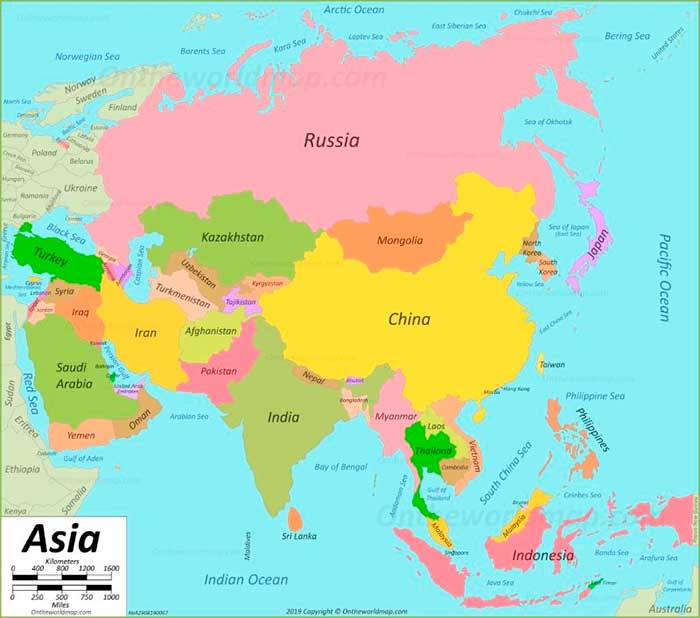
Every country or city has a handful of must-see attractions. You can learn more about a location by looking at a map than you can by wandering among the throngs of tourists. By exploring the surroundings, you learn about the area’s geology and other natural features such as lakes, mountains, forests, and more.
It helps you get a better sense of where you’re going, which may help you get the most out of your vacation. As a result, you’ll have a clearer picture of where to travel, when to go, and what activities you may participate in while you’re there. These locations may also be labeled with photographs or videos that might help you get a sense of what to anticipate.
What should you know about Asia?
As the world’s biggest and most diversified continent, Asia has plenty to offer its inhabitants. The eastern four-fifths of the Eurasian continent is occupied by it. To characterize such a large area using the phrase “Asian” might obscure the immense variety of the places it contains, which is why the term is more of a geographic term than a homogenous continent. Asia boasts the highest and lowest points on Earth, the world’s longest coastline, and the broadest range of climatic extremes. As a result, Asia is home to the world’s most diverse array of plant and animal species. As a result, Asia’s inhabitants have developed the widest range of human adaptations found anywhere else on Earth.
The origin of Asia’s name has been debated for centuries, and different theories have been put forward. In ancient times, Greeks used it to refer to the areas east of their country. Possibly derived from the Assyrian word asu, which means “east.” There is another probable explanation for the origin of the term “Anatolia,” which was initially used to refer to Anatolia (modern-day Anatolia, which is the westernmost part of mainland Asia) and subsequently expanded to apply to all of Anatolia’s neighbors. This designation was expanded to include the whole geographical mass when Western explorers first arrived in South and East Asia in early modern times.
As a result of climate change, Asia’s population is dispersed unevenly. Population concentrations may be seen in western Asia, the Indian subcontinent, and the eastern part of China. Central and North Asia, whose harsh temperatures restrict agricultural output, are still sparsely inhabited, whereas the Pacific frontiers and the islands of the Pacific Ocean are home to substantial populations. As a result of this, Asia is home to more than three-quarters of the world’s population.
Many smaller faiths, as well as the world’s five main monotheistic religions, have their origins in Asia. Christianity is the only religion that originated outside of Asia, however, it has a significant presence in Asian nations. Buddhism has had a wider effect outside of its home in India and is widespread in China, South Korea, Japan, Southeast Asia, and Sri Lanka in a variety of forms. Outside of Arabia, Islam has made its way eastward to Asia’s southern and southeast coasts. Most of Hinduism’s adherents reside in India to get clear ideas and details visit Asia Map.
Facts about Asia
- It’s the biggest continent on Earth.
- The biggest concentration of billionaires in the world may be found in Asia.
- The world’s tallest mountains may be found here.
- It has a wide range of organisms.
- Asia is home to 60% of the world’s population, making it the most populous continent.
- In certain Asian nations, insects are considered a delicacy.
- A Star Wars-themed building may be found in Singapore.
- Kyoto, Japan, has around 1,600 temples.
- ‘Fragrant Harbor’ is what Hong Kong implies.
- 45 billion pairs of chopsticks are produced in China each year.
- Single folks in South Korea have their own Valentine’s Day.
How Asia map is helpful in studies
Students may practice their writing abilities by examining the similarities and differences between nations they’ve studied on a map. Maps of typical temperatures and rainfall quantities may also be used to teach numeracy abilities. Students may learn how to organize and categorize data by using a variety of map formats, which is an asset in almost every academic field. Students may also use their artistic abilities to make paper mache globes in art class if they’d like.
- Half of the world’s population lives in Asia.
- Studying Asia’s cultural and historical diversity offers students the opportunity to have a better understanding of the world around them.
- As a result of Asian economic upheavals, our global economic and political environment has changed significantly.
- Having a background in Asian studies and other subjects increases one’s chances of finding a job and working abroad.
Is it safe to travel to Asia?
It may be possible to venture off the usual path and discover new cuisines and cultures by traveling to Asia for a low cost. The for each count, on the other hand, is worth verifying. There are six nations in Asia, including Iran, Iraq, and Yemen, that are classified as Level 4 because of armed conflicts, criminality, and terrorist concerns. An exciting part of planning a vacation is writing up a thorough itinerary.
Asian Maps can help you plan every aspect of your trip, from where to eat and stay to what to see and do. Maps are a great tool for creating a comprehensive travel book, whether you use a physical map or an app on your phone.
If you’re planning a road trip, you’ll need a map to help you navigate. They offer you a sense of what to anticipate as you go down the path. If you’re looking for a secure and pleasant way to go where you’re going, this app will help you out. It also allows you to choose different routes that may be quicker or more suited to your method of transportation.


